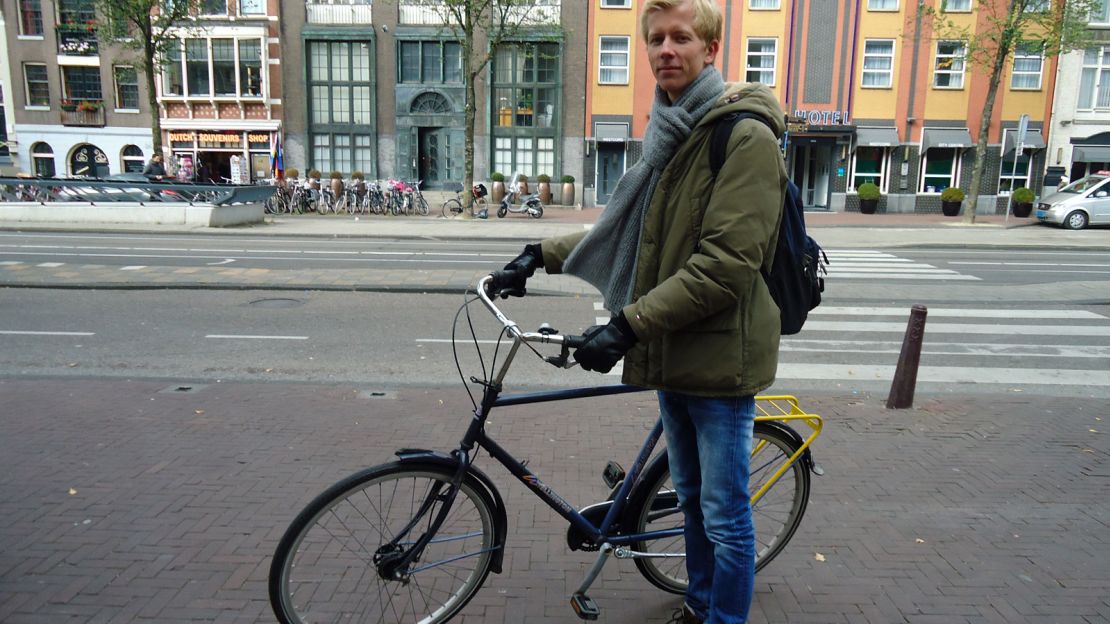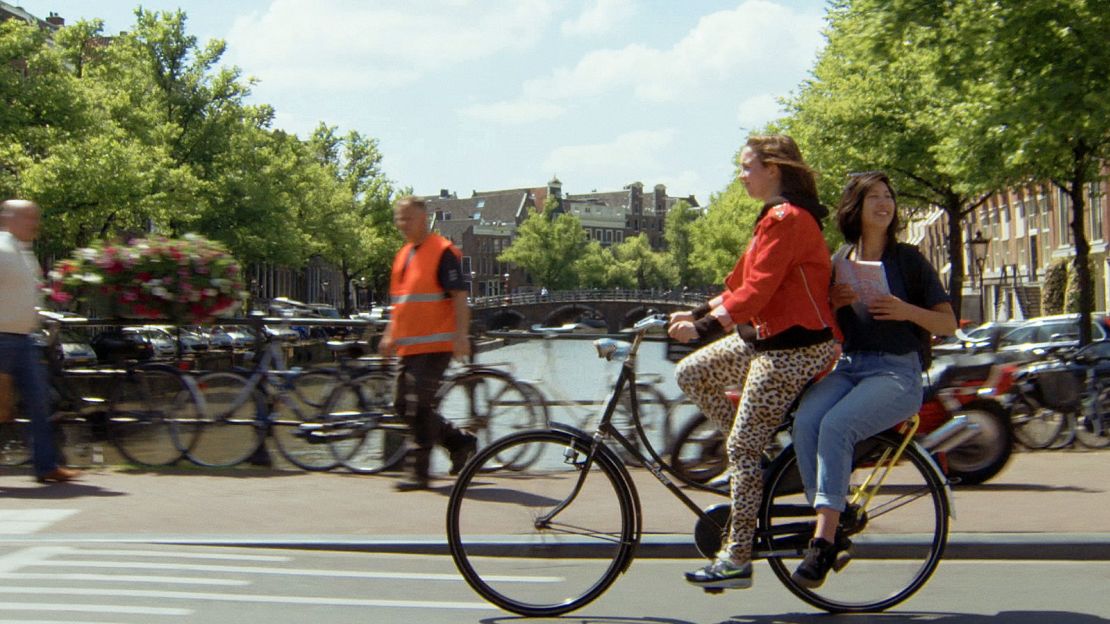“Wait, wait, you’ll have to stop!”
I’m running behind a slow-moving bike in one of Amsterdam’s many cycle lanes in a failed attempt to hop on to the yellow luggage rack at the back and hitch a ride.
The young man offering me a lift thinks it’s easy to jump on.
I beg to differ.
My hitchhiking attempt is part of the Yellow Backie scheme launched in 2015 in the Dutch capital as a way to encourage positive exchanges between locals and tourists.
The idea is that visitors – or even locals if they wish – who shout “backie” whenever they spy a cycle with a yellow luggage rack, can travel a short distance sitting on the back and enjoy a brief conversation.
Eventually, Bob Bulthuis, the 23-year-old student who I’m chasing, comes to a complete halt and lets me position myself correctly on his bike before he begins pedaling down the Nieuwezijds Voorburgwal, a busy street in central Amsterdam.
As other cyclists speedily overtake us, I cling on tight to Bulthuis’s waist and ask what he is studying, what he hopes to do in the future and we discuss the Dutch national soccer team’s prospects.
Well, I say ask him but mostly I yell my queries at him over the sound of traffic while attempting to stifle my worries of falling off – I feel as though I am constantly slipping down the luggage rack.
Later that day, while watching others giving a backie I realize this was because I was lifting my legs too high. I should have let them dangle just slightly off the ground.
‘More effort’

We pass by the outskirts of the Dam Square where throngs of tourists congregate, beyond the Nieuwe Kerk, a 15-century church, and take a right turn as we leave behind the Royal Palace and begin riding along the Singel canal.
While it’s illegal in some countries, such as the UK, in the Netherlands, giving a backie is extremely common.
Finally, we pass through a narrow street on the outskirts of the Red Light District – Amsterdam’s legalized prostitution zone – before I disembark.
Most of these rides with locals and tourists are short, sometimes from one end of the street to other.
I ask Bulthuis whether having someone ride on the back of his bike is difficult.
“It’s not hard but it’s different,” he says. “You have to put more effort in, especially when going over the bridges, for example, you have to push.”
I’m the fourth passenger who has ridden pillion on Bulthuis’s bike since he had his yellow luggage rack fitted two months ago, having heard about the idea on Facebook.
“It’s about meeting new people of course but it’s also about the image it reflects, because in Amsterdam people are always in a hurry when they are on their bikes. It’s good when you can, to be open for other people and take the time to look around you,” he says.
For someone who has never been to Amsterdam before, it’s difficult to imagine the sheer scale of bicycles per square meter in this city.
Cycling tyranny

With an estimated 880,000 bikes, there are more cycles than people here and they quite simply rule on the some 500 kilometers of cycle paths.
There’s no mistaking the jangling sound of one after the other whizzing past on narrow side streets or main thoroughfares.
There’s also no mistaking the exasperated sighs and tutting noises directed at anyone getting caught in their path.
Staying out of harm’s way is easier said than done, however.
Bikes in the Dutch capital have right of way from both right and left. There’s no escaping them.
Furthermore, Amsterdammers are typically fast, slowing down for no one.
Nothing identifies tourists more than trying and failing to dive out of the way of oncoming bicycles.
It’s exactly these reasons that encouraged Yellow Bike (Nieuwezijds Kolk 29, Amsterdam; +31 206 20 69 40), the long-running rental company, to set up its backie initiative this summer.
“In the Dutch press, there has been a lot of talk about there’s maybe too many tourists in Amsterdam and it being too busy,” says Martin Luyckx, Yellow Bike’s communications manager.
“Instead of being all negative about it, we wanted to do something positive because Yellow Bike has been around for 25 years, and on a daily basis we work with tourists and we see how much fun the interaction can be between tourists and the locals.
“So we wanted to do something with that and came up with the idea to resolve this issue with Yellow Backie.”

Making a connection
Since its launch in August, between 100 and 130 people have signed up to become “backie” drivers.
Most are based in Amsterdam, but other cities in the Netherlands, including Utrecht and Haarlem, are involved and the number is expected to grow.
To take part, participants must prove themselves with a short email explaining the motivation behind wanting to be a driver.
“We just want to make sure that people are on the same page. We don’t want them to be asking for money for giving a lift. We don’t want to start a little business in luggage racks so we are searching for drivers that are looking to make that connection with tourists,” says Luyckx.
The idea is now attracting attention worldwide and the Yellow Backie team says they’re receiving emails from all over the globe including the U.S., Canada, Turkey and even as far afield as Taiwan.
So does the company ship out yellow luggage racks?
“No, we don’t ship it. We just tell them they’re more than welcome to spray paint their own luggage rack yellow. People in the Netherlands are also more than welcome to do that. We can’t be giving away free luggage racks forever.
“We just want to spark some love between tourists and locals so it would be a good thing if a yellow luggage rack would symbolize that state of mind everywhere in the world.”
Halima Ali is a London-based freelance journalist and editor. She tweets @Halima_Ali







